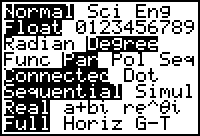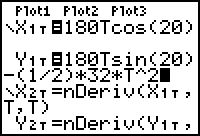It is often useful to find a vector function that models the path of a projectile. Such a function can yield the particle's position at time t as well as its velocity and acceleration. This lesson will explore finding the function that models the path of such an object given some initial information.
Finding the Position Vector
A projectile is fired from ground level. If the starting point for the projectile is considered to be the origin and if air resistance is neglected, the position vector for the projectile at time t is
where v0 is the initial velocity of the projectile,
![]() is the angle from the horizontal at which the projectile is fired and g is the acceleration due to gravity. When t is measured in seconds and distance is measured in feet, the acceleration due to gravity is given by g = 32 ft/sec each second. If distance is measured in meters, g = 9.8 m/sec2.
is the angle from the horizontal at which the projectile is fired and g is the acceleration due to gravity. When t is measured in seconds and distance is measured in feet, the acceleration due to gravity is given by g = 32 ft/sec each second. If distance is measured in meters, g = 9.8 m/sec2.
The position vector can also be represented with the corresponding parametric equations
 .
.
A Specific Example
Suppose a projectile is fired at an angle of
![]() = 20°
from the horizontal with an initial velocity of 180 ft/sec. Graph the path of the projectile using 32 ft/sec2 for g.
= 20°
from the horizontal with an initial velocity of 180 ft/sec. Graph the path of the projectile using 32 ft/sec2 for g.
- Select Degree in the Mode menu.

- Set X1T = 180*T*cos(20).
- Set Y1T = 180*T*sin(20) - (1/2)*32*T^2.
- Unselect X2T and Y2T.
- Unselect X3T and Y3T.

- Enter the following window values: [0, 5, 0.1] x [0, 800, 100] x [-50, 100, 10].
- Graph the path of the object.
26.3.1 Use the trace key to approximate when the projectile reaches its highest point and estimate the position vector at the highest point. Click here for the answer.
Recalling Previous Functions
If you have not cleared the variables X2T, Y2T and X3T, Y3T since Lesson 26.2, these variables should still be defined as the velocity and acceleration vectors for the position vector stored in X1T and Y1T. If you have cleared these variables, redefine them as they were defined in Lesson 26.2.
- Set X2T = nDeriv(X1T,T,T).
- Set Y2T = nDeriv(Y1T,T,T).
- Set X3T = nDeriv(X2T,T,T).
- Set Y3T = nDeriv(Y2T,T,T).
26.3.2 Select the velocity parametric equations. Evaluate the velocity vector at the value of t when the projectile reaches its highest point. Interpret the meaning of this vector in terms of the projectile motion.
Click here for the answer.
|
|||
|
|
|||
26.3.3 Select the acceleration parametric equations. Evaluate the acceleration vector at several values of t. Interpret the meaning of this vector in terms of the projectile motion.
Click here for the answer.